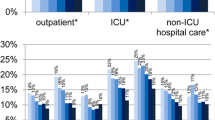Abstract
Objectives
A temporal relationship between the increasing use of antibiotics and the increasing levels of antibiotic resistance has been established for Streptococcus pneumoniae. There are also data that support the presence of a geographic correlation between the level of resistance and the pattern of use among different countries and even within the same country. The aim of this study was to evaluate the potential geographic correlation between the use of β-lactams and erythromycin in different Italian regions and the resistance of these antibiotics to invasive strains of S. pneumoniae during the period 1999–2000.
Methods
Ecological study
Results
In Italy the mean level of resistance for penicillin and erythromycin was 11.4% and 28.9%, respectively. The highest level of resistance for both antibiotics was observed in central and southern regions (i.e. Campania, Lazio and the combined regions of Calabria, Puglia and Sicilia). These regions were also those with the highest consumption of antibiotics. A strong correlation was found between the prevalence of resistance to erythromycin and the regional use of macrolides (r=0.93, P=0.001) and β-lactams (r=0.84, P=0.002). With regard to penicillin resistance, the greatest correlation was observed for oral penicillin (r=0.85, P=0.002).
Conclusion
Our study provides further evidence of the association between regional level of antibiotic use and prevalence of antibiotic resistance.
Similar content being viewed by others
References
Diekema J, Brueggemann AB, Doern GV(2000) Antimicrobial-drug use and changes in resistance in Streptococcus pneumoniae. Emerg Infect Dis 6:552–556
Granizo JJ, Aguilar L, Casal J, García-Rey C, Dal Ré R, Baquero F (2000) Streptococcus pneumoniae resistance to erythromycin and penicillin in relation to macrolide and β-lactam consumption in Spain (1979–1997). J Antimicrob Chemother 46:767–773
Čižman M, Pokorn M, Seme K, Oražen A, Paragy M (2001) The relationship between trends in macrolides use and resistance to macrolides of common respiratory pathogens. J Antimicrob Chemother 47:475–477
Pihlajamäki M, Kotilainen P, Kaurila T, Klaukka T, Palva E, Huovinen P et al (2001) Macrolide-resistant Streptococcus pneumoniae and use of antimicrobial agents. Clin Infect Dis 33:483–488
Felmingham D, Gruneberg RN (2000) The Alexander project 1996–1997: latest susceptibility data from this international study of bacterial pathogens from community-acquired lower respiratory tract infections. J Antimicrob Chemother 45:191–203
European Antimicrobial Resistance Surveillance System (2001) Annual report 2001.http://www.earss.rivm.nl
Moro ML, Pantosti A, Boccia D (2002) Sorveglianza dell’antibiotico-resistenza in infezioni invasive di Streptococcus pneumoniae e Staphylococcus aureus: il progetto EARSS in Italia (Aprile 1999—Aprile 2002). Ann Ig 14:361–371
National Committee for Clinical Laboratory Standards (2000) Methods for dilution. Antimicrobial susceptibility tests for bacteria that grow aerobically, fifth edn. Approved standard M7-A5. NCCLS, Wayne, PA
Drug Utilisation Monitoring Centre (2000) Drug utilisation in Italy. National report year 2000. Ministero della Salute,http://www.ministerosalute.it/medicinali/osmed/sezEng.jsp
Traversa G, Bianchi C, Da Cas R, Venegoni M (2002) L’uso degli antibiotici soggetti a nota in Italia Bollettino di Informazione sui Farmaci.http://www.mimisterosalute.it/medicinali/resources/documenti/bollettino/Bif_1_2_2002.pfd
Mölstad S, Stålsby Lundborg C, Karlsson A, Cars O (2002) Antibiotic prescription rates vary markedly between 13 European countries. Scand J Infect Dis 34:366–371
Petrosillo N, Pantosti A, Bordi E, Spano A, Del Grosso M, Tallarida B et al (2002) Prevalence, determinants, and molecular epidemiology of Streptococcus pneumoniae isolates colonizing the nasopharynx of healthy children in Rome. Eur J Clin Microb Infect Dis 21:181–188
Lipsitch M, Samore M (2002) Antimicrobial use and antimicrobial resistance: a population perspective. Emerg Infect Dis 8:347–354
García-Rey C, Aguillar L, Baquero F, Casal J, Dal-Ré R (2002) Importance of local variations in antibiotic consumption and geographical differences of erythromycin and penicillin resistance in Streptococcus pneumoniae. J Clin Microbiol 40:159–164
Gould IM (1999) A review of the role of antibiotic policies in the control of antibiotic resistance. J Antimicrob Chemmother 43:459–465
Author information
Authors and Affiliations
Corresponding author
Rights and permissions
About this article
Cite this article
Boccia, D., Alegiani, S.S., Pantosti, A. et al. The geographic relationship between the use of antimicrobial drugs and the pattern of resistance for Streptococcus pneumoniae in Italy. Eur J Clin Pharmacol 60, 115–119 (2004). https://doi.org/10.1007/s00228-003-0724-x
Received:
Accepted:
Published:
Issue Date:
DOI: https://doi.org/10.1007/s00228-003-0724-x



